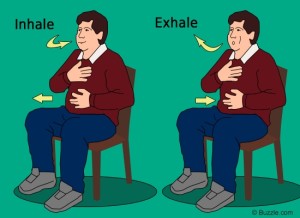Blog
Diaphragmatic Breathing Reduces Low Back Pain
Tags: back pain exercises, diaphragmatic breathing, low back pain treatment, natural pain relief, pain management, pain relief, pain treatment
 Diaphragmatic breathing is a simple, natural solution that helps reduce low back pain. It sounds too good to be true but studies have shown that people with chronic low back pain breathe differently compared to people without low back pain. Faulty breathing mechanics also lead to neck tension, pain, and even headaches. We have a muscle that is built for breathing called the diaphragm. Instead of using the diaphragm to breathe, many people use the inspiratory accessory muscles. When taking a breath, the muscle doing the majority of the work should be the diaphragm. In people with low back and neck pain, the diaphragm is underactive while the accessory muscles are overactive.
Diaphragmatic breathing is a simple, natural solution that helps reduce low back pain. It sounds too good to be true but studies have shown that people with chronic low back pain breathe differently compared to people without low back pain. Faulty breathing mechanics also lead to neck tension, pain, and even headaches. We have a muscle that is built for breathing called the diaphragm. Instead of using the diaphragm to breathe, many people use the inspiratory accessory muscles. When taking a breath, the muscle doing the majority of the work should be the diaphragm. In people with low back and neck pain, the diaphragm is underactive while the accessory muscles are overactive.
The inspiratory accessory muscles include the sternocleidomastoid, scalenes, serratus anterior, pectoralis major and minor, upper trapezius, latissimus dorsi, erector spinae (thoracic), iliocostalis lumborum, quadratus lumborum, serratus posterior superior and inferior, levatores costarum, transversus thoracis, and subclavius. These muscles, connected to the neck and low back, create more stress, strain, and compression through the spine when they are doing the majority of breathing work. Stress, strain, and compression through the spine eventually lead to pain. This is why using the diaphragm as it is designed results in decreased neck and back pain; the muscles that connect to the neck and back exert less force through the spine when not used as the primary breathing muscles.
To test your breathing mechanics, put your left hand on your stomach at your navel and the right hand over your chest. Now just breathe. If your right hand (the hand on your chest) moves more compared to your left hand (the hand on your stomach), you are using the accessory muscles more than the diaphragm. This is very common and easily corrected. You can practice breathing and work on the diaphragm while standing, sitting, or while lying on your back.
Assume the same hand position as described above with the left hand over the navel region and the right hand over your chest. Place your tongue on the roof of your mouth behind your front teeth. Now take a deep breath in through your nose and breathe out through pursed lips. As you breathe out gently tighten your stomach muscles and let them fall in towards your spine. Note your left hand over your stomach; the left hand should move noticeably and be pushed outwards by your stomach. The stomach should “fill” the left hand. The right hand should move minimally if at all, the less the better. Breathing this way assures the diaphragm is the primary muscle of inspiration.
Start with breathing work for two minutes three or four times per day and work up to five minutes over the course of one month. Just one two-minute session of diaphragmatic breathing will reduce tension in muscles along the neck and back. As your diaphragm becomes stronger, you can work on breathing this way during dynamic activities. Since your body is built to breathe in this manner, with practice it will begin to use the diaphragm more regularly instead of the accessory muscles. This simple exercise will reduce excessive tension, stress, and strain through the neck and lumbar spine.
Diaphragmatic breathing may be just what you need to help reduce low back, neck, or headache pain.